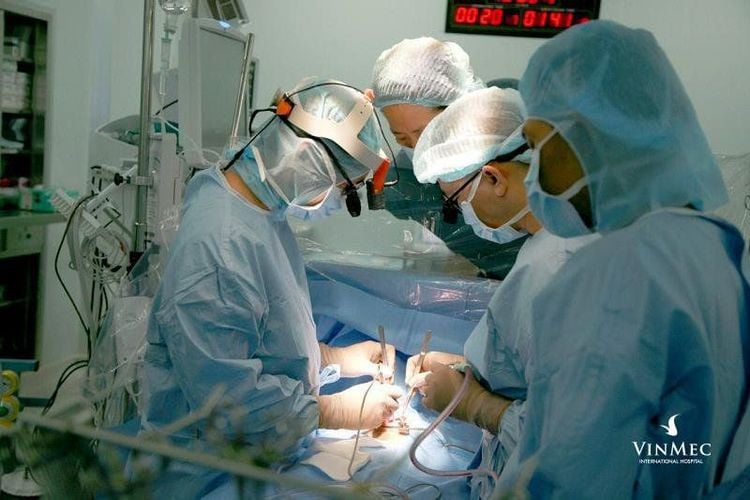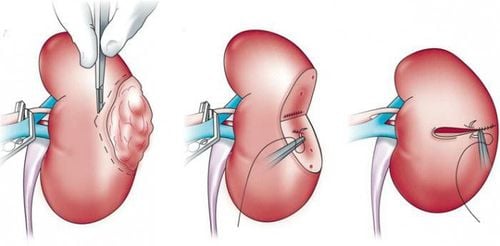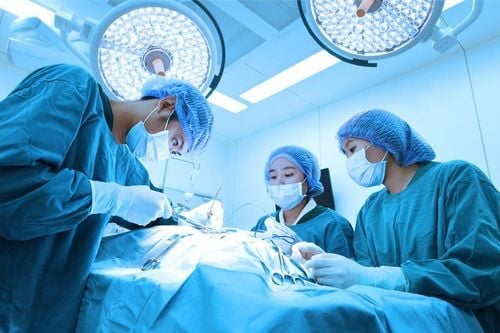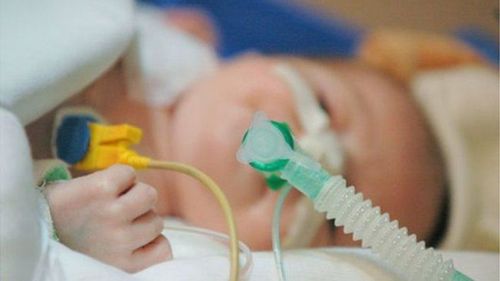This is an automatically translated article.
The article was professionally consulted by Doctor of Urology Department, Vinmec Central Park International General Hospital.Laparoscopic nephrectomy is a safe and effective technique that allows partial or total nephrectomy in cases of renal failure, in renal cancer, or nephrectomy in intraoperative kidney donors. kidney transplant.
1. What is Laparoscopic Nephrectomy?
Laparoscopic nephrectomy (LN) is surgery performed with medical instruments inserted inside the body through small cuts in the abdomen. The surgical image is observed on the screen with many times magnification. As a result, the doctor accurately assesses the injury and performs the surgery better.
The patient will be put to sleep. The surgeon will place 3 to 4 trocars, from small cuts in the skin of the abdomen 5mm or 10-12mm long. Through these trocars, the doctor will insert laparoscopic instruments into the abdominal cavity for surgical manipulation. Damage to the kidney will be detected and the doctor will remove part or all of the kidney from the patient's body.
2. In which cases is laparoscopic nephrectomy indicated?
Currently, laparoscopic nephrectomy is being applied in many cases such as:
Treatment of malignancies: kidney cancer, ureteral and ureteral cancer. Treatment of benign diseases: kidney failure due to benign disease. Nephrectomy for organ donors in kidney transplant surgery. 2.1. Laparoscopic nephrectomy for malignant diseases Kidney cancer Kidney cancer is the leading cause among the reasons why patients have to undergo nephrectomy in developed countries today. Among kidney cancers, renal cell cancer is the most common type, ranking third among urinary tract cancers, after bladder cancer and prostate cancer.
Urinary tract cancer of the renal pelvis and ureters Ureteral cancer is cancer that originates in the epithelial cells lining the excretory tract such as the renal pelvis, ureters, and bladder. The rate of ureteral cancer or pyelonephritis is usually not high and is often associated with bladder cancer.
Standard nephrectomy for upper urinary tract cancer includes ureteral cancer of the renal pelvis and ureter including nephrectomy and the entire ureter and part of the bladder.
2.2. Laparoscopic nephrectomy for the treatment of benign diseases

Cắt thận nội soi điều trị các bệnh lý lành tính
In most cases of benign kidney disease for which nephrectomy is indicated, laparoscopic surgery is the treatment of first choice.
Kidney failure is the cause in the majority of indications for nephrectomy to treat benign diseases, including the following cases:
Urinary tract stones: The main cause of kidney failure, including urolithiasis late detection and obstructed kidney stones or repeated surgery. Congenital pathologies such as stenosis of the ureteropelvic junction, ectopic ureter, maximal dilatation of the ureter. Chronic nephritis, tuberculosis nephritis... Kidney disease caused by reflux of urine from the bladder into the ureters and renal pelvis Hypertension secondary to renal vascular diseases. Progressive polycystic kidney disease 2.3. Living Donor Nephrectomy Currently, the number of people volunteering to donate kidneys is increasing. In which, there is a great contribution of laparoscopic nephrectomy technique. With advantages such as less trauma, aesthetics, and quick recovery, it has partly reduced the fear of kidney donors. Laparoscopic nephrectomy in living donors currently accounts for 50% of all noncancerous laparoscopic nephrectomy cases.
Laparoscopic surgery to remove the kidney of a living donor for transplantation requires meticulousness, high accuracy, avoiding damage to the kidney, especially the renal peduncle must be dissected to ensure renal vascular requirements in kidney transplantation. . In this case, the kidney after being removed will be removed completely through a small opening in the abdominal wall and brought to transplant into the body for the recipient.
3. Advantages of laparoscopic nephrectomy
The outstanding advantage of laparoscopic nephrectomy is that it is less invasive. The surgery is done through small incisions in the abdominal wall, so it is less painful than with a conventional open surgery. In addition, this surgery is also considered safe, patients recover faster.
Especially, for elderly patients, patients with chronic diseases or many health problems, laparoscopic nephrectomy may be the right choice for patients at risk of surgery. high.
Laparoscopic nephrectomy is a difficult technique, requiring many factors such as: experience and proficiency of the surgeon. In addition, modern equipment and machinery is also one of the contributing factors. important part of successful surgery. Therefore, most patients when performing this technique often choose large hospitals with modern equipment systems and high-quality operating rooms. Thanks to that, the rate of postoperative complications, the rate of infection is also significantly reduced.
4. Endoscopic nephrectomy at Vinmec Central Park International Hospital
Laparoscopic nephrectomy is a difficult technique that requires modern machinery. Therefore, Vinmec Central Park International General Hospital is now equipped with the new generation Dex Flex Robot system with a flexible robot arm that allows the surgeon to perform many precise and flexible operations when cutting, suture, clamp, weld, pump CO2... Robot can perform complex surgical techniques that other endoscopic surgery methods are difficult or impossible to perform.
Also here, the doctors who directly perform laparoscopic nephrectomy of the Department of Surgery, Vinmec Central Park Hospital are the leading experts in urology:
Specialist Doctor II Nguyen Minh Quang Master Doctor Nguyen Tan Cuong To register for examination and treatment of kidney and urinary problems, you can register here or contact hotline 0283 6221 166 for support.













